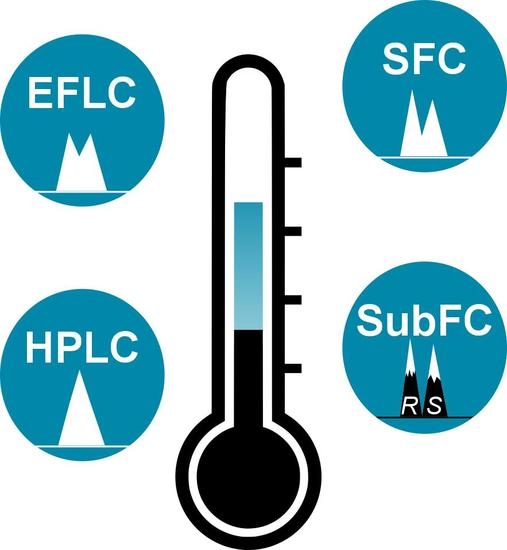Subcritical Fluid Chromatography at Sub-Ambient Temperatures for the Chiral Resolution of Ketamine Metabolites with Rapid-Onset Antidepressant Effects
Abstract
1. Introduction
2. Results
2.1. Stationary Phase Screening
2.2. Molecular Modelling Studies
2.3. Effects of Elution Mode
2.4. Mobile Phase Optimization
2.5. Temperature Effects
2.6. Mobile Phase Homogeneity
2.7. Application to Antidepressant Drug Formulations
3. Discussion
4. Materials and Methods
4.1. Chemicals
4.2. Instruments
4.3. Chromatographic Parameters
4.4. Molecular Modelling
4.5. Application to Pharmaceutical Formulations
Supplementary Materials
Author Contributions
Funding
Acknowledgments
Conflicts of Interest
References
- Ketamine Nasal Spray Medication for Treatment-Resistant Depression. Available online: https://www.fda.gov/news-events/press-announcements/fda-approves-new-nasal-spray-medication-treatment-resistant-depression-available-only-certified (accessed on 30 April 2019).
- Zanos, P.; Moaddel, R.; Morris, P.J.; Riggs, L.M.; Highland, J.N.; Georgiou, P.; Pereira, E.F.R.; Albuquerque, E.X.; Thomas, C.J.; Zarate, C.A.; et al. Ketamine and Ketamine Metabolite Pharmacology: Insights into Therapeutic Mechanisms. Pharmacol. Rev. 2018, 70, 621–660. [Google Scholar] [CrossRef] [PubMed]
- Grunebaum, M.F.; Ellis, S.P.; Keilp, J.G.; Moitra, V.K.; Cooper, T.B.; Marver, J.E.; Burke, A.K.; Milak, M.S.; Sublette, M.E.; Oquendo, M.A.; et al. Ketamine versus midazolam in bipolar depression with suicidal thoughts: A pilot midazolam-controlled randomized clinical trial. Bipolar Disord. 2017, 19, 176–183. [Google Scholar] [CrossRef] [PubMed]
- Aust, S.; Gärtner, M.; Basso, L.; Otte, C.; Wingenfeld, K.; Chae, W.R.; Heuser-Collier, I.; Regen, F.; Cosma, N.C.; van Hall, F.; et al. Anxiety during ketamine infusions is associated with negative treatment responses in major depressive disorder. Eur. Neuropsychopharmacol. 2019, 29, 529–538. [Google Scholar] [CrossRef]
- Cusin, C. Ketamine as a Rapid Antidepressant. In The Massachusetts General Hospital Guide to Depression; Shapero, B.G., Mischoulon, D., Cusin, C., Eds.; Springer International Publishing: Cham, New York City, NY, USA, 2019; pp. 139–145. ISBN 978-3-319-97240-4. [Google Scholar]
- Keiser, M.; Hasan, M.; Oswald, S. Affinity of Ketamine to Clinically Relevant Transporters. Mol. Pharm. 2018, 15, 326–331. [Google Scholar] [CrossRef]
- Naidoo, V.; Mdanda, S.; Ntshangase, S.; Naicker, T.; Kruger, H.G.; Govender, T.; Naidoo, P.; Baijnath, S. Brain penetration of ketamine: Intranasal delivery vs. parenteral routes of administraion. J. Psychiatr. Res. 2019, 112, 7–11. [Google Scholar] [CrossRef]
- Li, W.; Liu, J.; Fan, M.; Li, Z.; Chen, Y.; Zhang, G.; Huang, Z.; Zhang, L. Scale-Up Synthesis and Identification of GLYX-13, a NMDAR Glycine-Site Partial Agonist for the Treatment of Major Depressive Disorder. Molecules 2018, 23, 996. [Google Scholar] [CrossRef] [PubMed]
- Suzuki, K.; Nosyreva, E.; Hunt, K.W.; Kavalali, E.T.; Monteggia, L.M. Effects of a ketamine metabolite on synaptic NMDAR function. Nature 2017, 546, E1–E3. [Google Scholar] [CrossRef]
- Zanos, P.; Moaddel, R.; Morris, P.J.; Georgiou, P.; Fischell, J.; Elmer, G.I.; Alkondon, M.; Yuan, P.; Pribut, H.J.; Singh, N.S.; et al. NMDAR inhibition-independent antidepressant actions of ketamine metabolites. Nature 2016, 533, 481–486. [Google Scholar] [CrossRef] [PubMed]
- Yang, Y.; Cui, Y.; Sang, K.; Dong, Y.; Ni, Z.; Ma, S.; Hu, H. Ketamine blocks bursting in the lateral habenula to rapidly relieve depression. Nature 2018, 554, 317–322. [Google Scholar] [CrossRef]
- Yang, C.; Kobayashi, S.; Nakao, K.; Dong, C.; Han, M.; Qu, Y.; Ren, Q.; Zhang, J.; Ma, M.; Toki, H.; et al. AMPA Receptor Activation–Independent Antidepressant Actions of Ketamine Metabolite (S)-Norketamine. Biol. Psychiatry 2018, 84, 591–600. [Google Scholar] [CrossRef]
- Pham, T.H.; Gardier, A.M. Fast-acting antidepressant activity of ketamine: highlights on brain serotonin, glutamate, and GABA neurotransmission in preclinical studies. Pharmacol. Ther. 2019. [Google Scholar] [CrossRef] [PubMed]
- Lumsden, E.W.; Troppoli, T.A.; Myers, S.J.; Zanos, P.; Aracava, Y.; Kehr, J.; Lovett, J.; Kim, S.; Wang, F.-H.; Schmidt, S.; et al. Antidepressant-relevant concentrations of the ketamine metabolite (2R,6R)-hydroxynorketamine do not block NMDA receptor function. Proc. Natl. Acad. Sci. USA 2019, 116, 5160–5169. [Google Scholar] [CrossRef] [PubMed]
- Fukumoto, K.; Fogaça, M.V.; Liu, R.-J.; Duman, C.; Kato, T.; Li, X.-Y.; Duman, R.S. Activity-dependent brain-derived neurotrophic factor signaling is required for the antidepressant actions of (2R,6R)-hydroxynorketamine. Proc. Natl. Acad. Sci. USA 2019, 116, 297–302. [Google Scholar] [CrossRef]
- Hicks, M.B.; Farrell, W.; Aurigemma, C.; Lehmann, L.; Weisel, L.; Nadeau, K.; Lee, H.; Moraff, C.; Wong, M.; Huang, Y.; et al. Making the move towards modernized greener separations: introduction of the analytical method greenness score (AMGS) calculator. Green Chem. 2019, 21, 1816–1826. [Google Scholar] [CrossRef]
- Rossi, D.; Tarantino, M.; Rossino, G.; Rui, M.; Juza, M.; Collina, S. Approaches for multi-gram scale isolation of enantiomers for drug discovery. Expert Opin. Drug Discov. 2017, 12, 1253–1269. [Google Scholar] [CrossRef]
- Pilařová, V.; Plachká, K.; Khalikova, M.A.; Svec, F.; Nováková, L. Recent developments in supercritical fluid chromatography—Mass spectrometry: Is it a viable option for analysis of complex samples? Trends Anal. Chem. 2019, 112, 212–225. [Google Scholar] [CrossRef]
- Fassauer, G.M.; Hofstetter, R.; Hasan, M.; Oswald, S.; Modeß, C.; Siegmund, W.; Link, A. Ketamine metabolites with antidepressant effects: Fast, economical, and eco-friendly enantioselective separation based on supercritical-fluid chromatography (SFC) and single quadrupole MS detection. J. Pharm. Biomed. Anal. 2017, 146, 410–419. [Google Scholar] [CrossRef] [PubMed]
- Hasan, M.; Hofstetter, R.; Fassauer, G.M.; Link, A.; Siegmund, W.; Oswald, S. Quantitative chiral and achiral determination of ketamine and its metabolites by LC–MS/MS in human serum, urine and fecal samples. J. Pharm. Biomed. Anal. 2017, 139, 87–97. [Google Scholar] [CrossRef] [PubMed]
- Teixeira, J.; Tiritan, M.E.; Pinto, M.M.M.; Fernandes, C. Chiral Stationary Phases for Liquid Chromatography: Recent Developments. Molecules 2019, 24, 865. [Google Scholar] [CrossRef]
- Chen, L.; Dean, B.; Liang, X. Evaluation of polysaccharide-based chiral stationary phases in modern SFC–MS/MS for enantioselective bioanalysis. Bioanalysis 2019, 11, 251–266. [Google Scholar] [CrossRef] [PubMed]
- Peluso, P.; Dessì, A.; Dallocchio, R.; Mamane, V.; Cossu, S. Recent studies of docking and molecular dynamics simulation for liquid-phase enantioseparations. Electrophoresis 2019, 0, 1–16. [Google Scholar] [CrossRef] [PubMed]
- Tarafder, A. Metamorphosis of supercritical fluid chromatography to SFC: An Overview. Trends Anal. Chem. 2016, 81, 3–10. [Google Scholar] [CrossRef]
- Otsubo, M.; Motono, T.; Kitagawa, S.; Ohtani, H. Effect of Column Structure on Separation Efficiency in Low-Temperature HPLC Using Pure Liquid Carbon Dioxide as the Mobile Phase. Chromatography 2017, 38, 31–37. [Google Scholar] [CrossRef][Green Version]
- Bennett, R.; Biba, M.; Liu, J.; Haidar Ahmad, I.A.; Hicks, M.B.; Regalado, E.L. Enhanced fluidity liquid chromatography: A guide to scaling up from analytical to preparative separations. J. Chromatogr. A 2019, 1595, 190–198. [Google Scholar] [CrossRef] [PubMed]
- Bennett, R.; Olesik, S.V. Enhanced fluidity liquid chromatography of inulin fructans using ternary solvent strength and selectivity gradients. Anal. Chim. Acta 2018, 999, 161–168. [Google Scholar] [CrossRef] [PubMed]
- Bennett, R.; Olesik, S.V. Protein separations using enhanced-fluidity liquid chromatography. J. Chromatogr. A 2017, 1523, 257–264. [Google Scholar] [CrossRef] [PubMed]
- Khater, S.; Lozac’h, M.-A.; Adam, I.; Francotte, E.; West, C. Comparison of liquid and supercritical fluid chromatography mobile phases for enantioselective separations on polysaccharide stationary phases. J. Chromatogr. A 2016, 1467, 463–472. [Google Scholar] [CrossRef]
- West, C.; Konjaria, M.-L.; Shashviashvili, N.; Lemasson, E.; Bonnet, P.; Kakava, R.; Volonterio, A.; Chankvetadze, B. Enantioseparation of novel chiral sulfoxides on chlorinated polysaccharide stationary phases in supercritical fluid chromatography. J. Chromatogr. A 2017, 1499, 174–182. [Google Scholar] [CrossRef]
- Pirkle, W.H.; Wolf, C. Enantioseparations by subcritical fluid chromatography at cryogenic temperatures. J. Chromatogr. A 1997, 785, 173–178. [Google Scholar]
- Tyśkiewicz, K.; Gieysztor, R.; Maziarczyk, I.; Hodurek, P.; Rój, E.; Skalicka-Woźniak, K. Supercritical Fluid Chromatography with Photodiode Array Detection in the Determination of Fat-Soluble Vitamins in Hemp Seed Oil and Waste Fish Oil. Molecules 2018, 23, 1131. [Google Scholar] [CrossRef]
- Esketamine hydrochloride. In European Pharmacopoeia 9.3; EDQM: Strasbourg, France, 2017; pp. 4895–4896.
- Hofstetter, R.; Fassauer, G.M.; Link, A. Supercritical fluid extraction (SFE) of ketamine metabolites from dried urine and on-line quantification by supercritical fluid chromatography and single mass detection (on-line SFE–SFC–MS). J. Chromatogr. B 2018, 1076, 77–83. [Google Scholar] [CrossRef]
- Dascalu, A.-E.; Ghinet, A.; Billamboz, M.; Lipka, E. Performance comparison of chlorinated chiral stationary phases in supercritical fluid chromatography for separation of selected pyrrolidone derivatives. J. Pharm. Anal. 2019. [Google Scholar] [CrossRef]
- Lipka, E.; Dascalu, A.-E.; Messara, Y.; Tsutsqiridze, E.; Farkas, T.; Chankvetadze, B. Separation of enantiomers of native amino acids with polysaccharide-based chiral columns in supercritical fluid chromatography. J. Chromatogr. A 2019, 1585, 207–212. [Google Scholar] [CrossRef]
- Orosz, T.; Bajtai, A.; Minh Le, T.; Tanács, D.; Szakonyi, Z.; Fülöp, F.; Péter, A.; Ilisz, I. Chiral high-performance liquid and supercritical fluid chromatographic enantioseparations of limonene-based bicyclic aminoalcohols and aminodiols on polysaccharide-based chiral stationary phases. Biomed. Chromatogr. 2019, 33, e4517. [Google Scholar] [CrossRef]
- Hofstetter, R.K.; Hasan, M.; Fassauer, G.M.; Bock, C.; Surur, A.S.; Behnisch, S.; Grathwol, C.W.; Potlitz, F.; Oergel, T.; Siegmund, W.; et al. Simultaneous quantification of acidic and basic flupirtine metabolites by supercritical fluid chromatography according to European Medicines Agency validation. J. Chromatogr. A 2019. (In press) [CrossRef]
- Harps, L.C.; Joseph, J.F.; Parr, M.K. SFC for chiral separations in bioanalysis. J. Pharm. Biomed. Anal. 2019, 162, 47–59. [Google Scholar] [CrossRef] [PubMed]
- Kadkhodaei, K.; Forcher, L.; Schmid, M.G. Separation of enantiomers of new psychoactive substances by high-performance liquid chromatography. J. Sep. Sci. 2018, 41, 1274–1286. [Google Scholar] [CrossRef] [PubMed]
- Ikai, T.; Okamoto, Y. Structure Control of Polysaccharide Derivatives for Efficient Separation of Enantiomers by Chromatography. Chem. Rev. 2009, 109, 6077–6101. [Google Scholar] [CrossRef]
- Matarashvili, I.; Ghughunishvili, D.; Chankvetadze, L.; Takaishvili, N.; Khatiashvili, T.; Tsintsadze, M.; Farkas, T.; Bezhan, F. Separation of enantiomers of chiral weak acids with polysaccharide-based chiral columns and aqueous-organic mobile phases in high-performance liquid chromatography: Typical reversed-phase behavior? J. Chromatogr. A 2017, 1483, 86–92. [Google Scholar] [CrossRef] [PubMed]
- Wang, C.; Duan, Z.; Fan, L.; Li, J. Supercritical CO2 Fluid Extraction of Elaeagnus mollis Diels Seed Oil and Its Antioxidant Ability. Molecules 2019, 24, 911. [Google Scholar] [CrossRef]
- Wang, H.-L.; Chang, J.-C.; Fang, L.-W.; Hsu, H.-F.; Lee, L.-C.; Yang, J.-F.; Liang, M.-T.; Hsiao, P.-C.; Wang, C.-P.; Wang, S.-W.; et al. Bulnesia sarmientoi Supercritical Fluid Extract Exhibits Necroptotic Effects and Anti-Metastatic Activity on Lung Cancer Cells. Molecules 2018, 23, 3304. [Google Scholar] [CrossRef]
- Molino, A.; Larocca, V.; Di Sanzo, G.; Martino, M.; Casella, P.; Marino, T.; Karatza, D.; Musmarra, D. Extraction of Bioactive Compounds Using Supercritical Carbon Dioxide. Molecules 2019, 24, 782. [Google Scholar] [CrossRef] [PubMed]
- Molecular Operating Environment (MOE) Software Suite; Version 2019.01; Chemical Computing Group, ULC: Montreal, QC, Canada, 2019.
- Labute, P. LowModeMD - Implicit low-mode velocity filtering applied to conformational search of macrocycles and protein loops. J. Chem. Inf. Model. 2010, 50, 792–800. [Google Scholar] [CrossRef] [PubMed]
- West, C.; Melin, J.; Ansouri, H.; Mengue Metogo, M. Unravelling the effects of mobile phase additives in supercritical fluid chromatography. Part I: Polarity and acidity of the mobile phase. J. Chromatogr. A 2017, 1492, 136–143. [Google Scholar] [CrossRef] [PubMed]
- Zhu, B.; Zhao, F.; Yu, J.; Wang, Z.; Song, Y.; Li, Q. Chiral separation and a molecular modeling study of eight azole antifungals on the cellulose tris(3,5-dichlorophenylcarbamate) chiral stationary phase. New J. Chem. 2018, 42, 13421–13429. [Google Scholar] [CrossRef]
- Chromatographic Separation Techniques. In European Pharmacopoeia 9.8; EDQM: Strasbourg, France, 2019; pp. 4286–4293.
Sample Availability: Samples of the compounds are not available from the authors. |
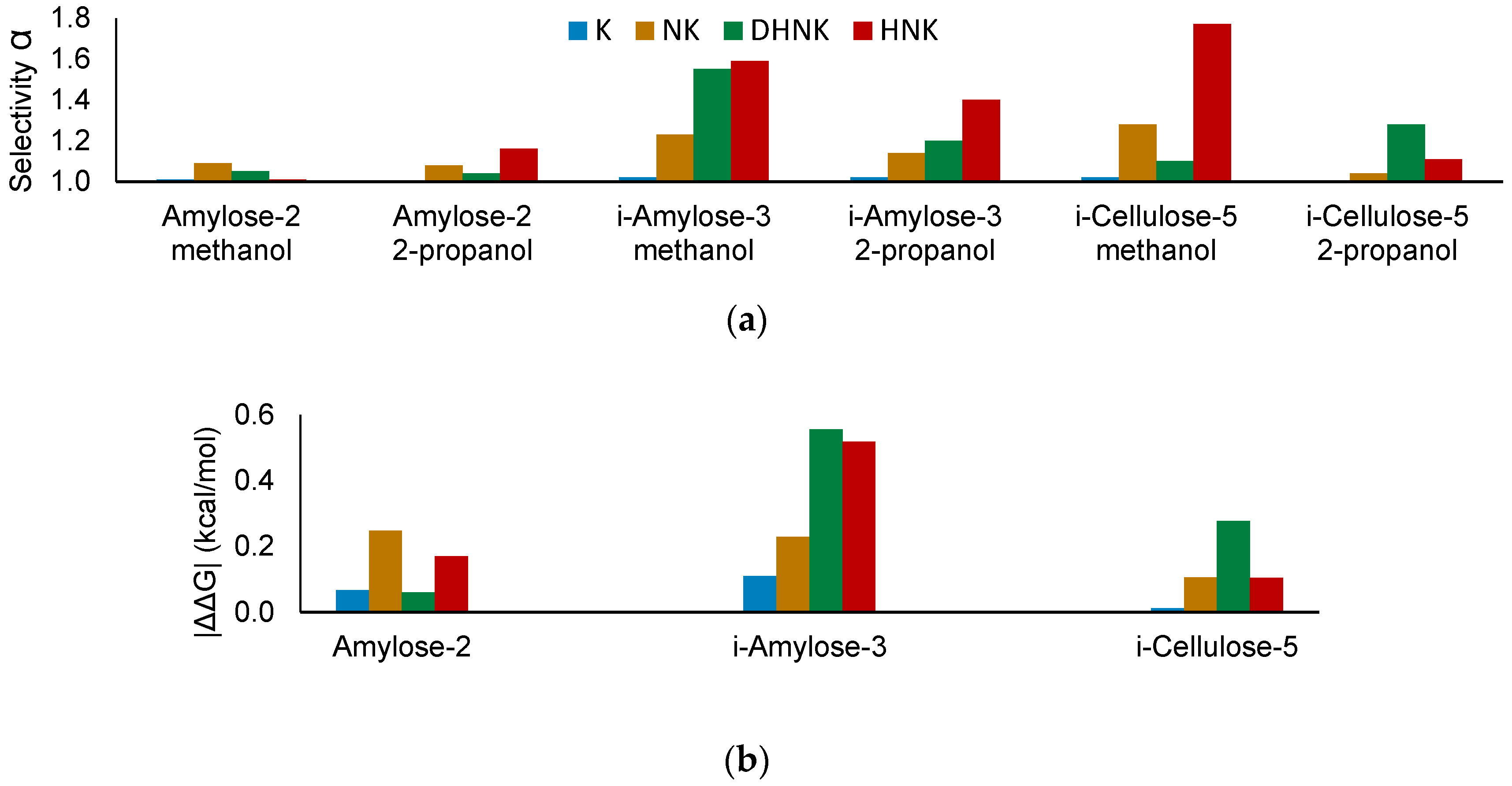
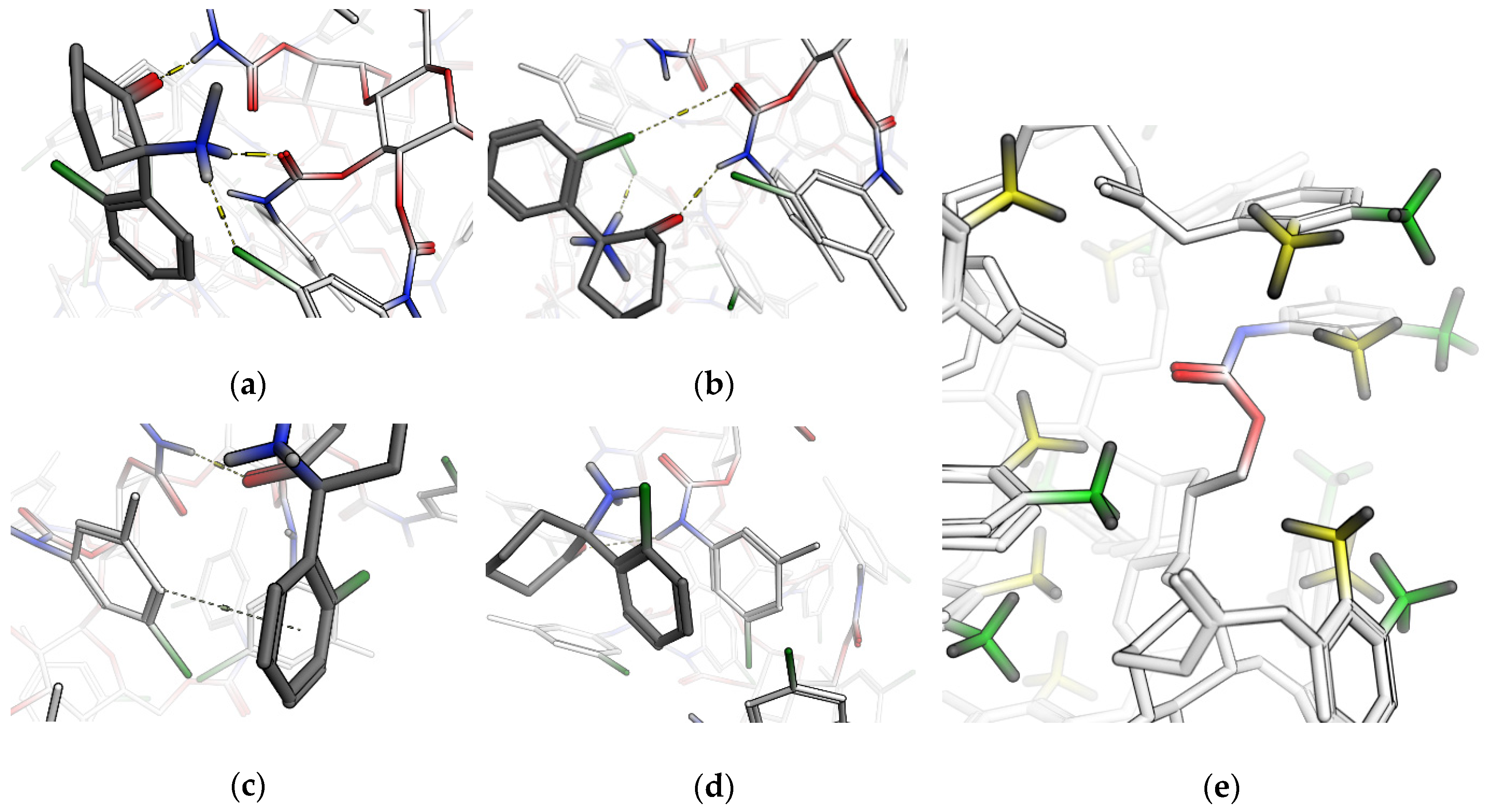
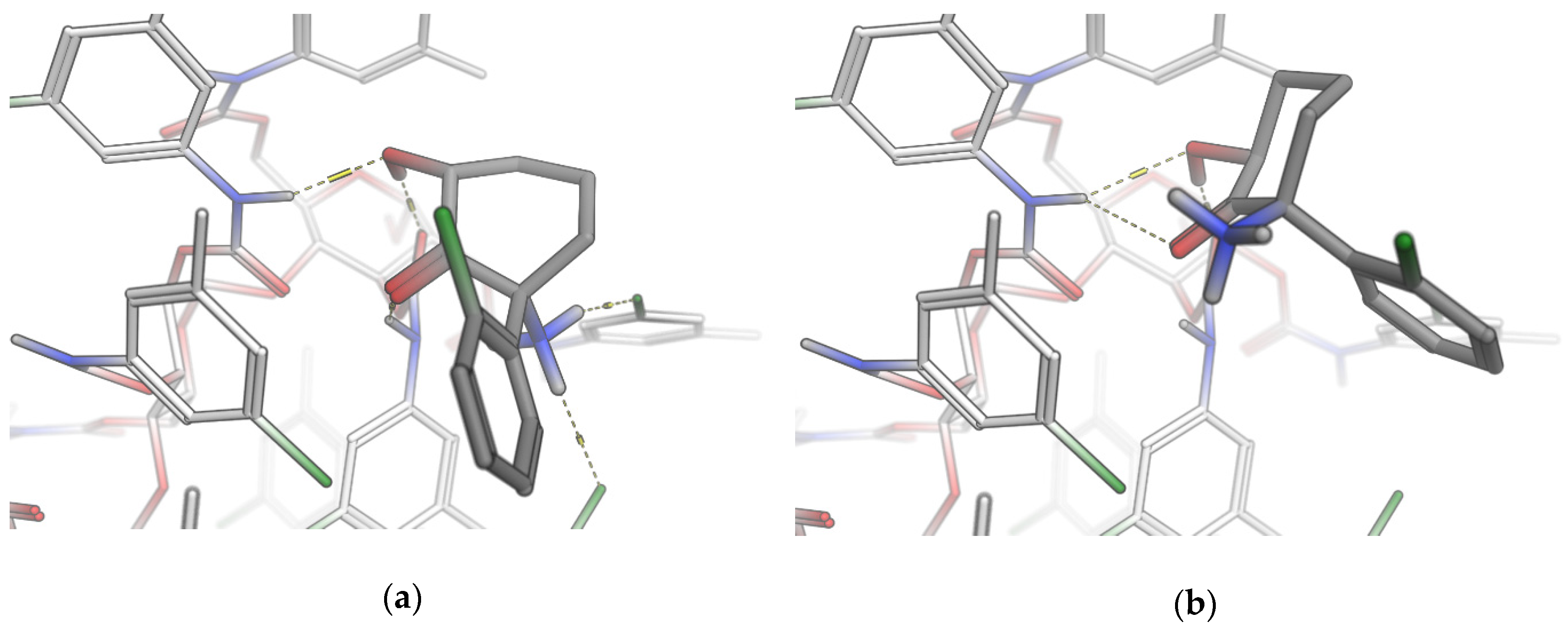
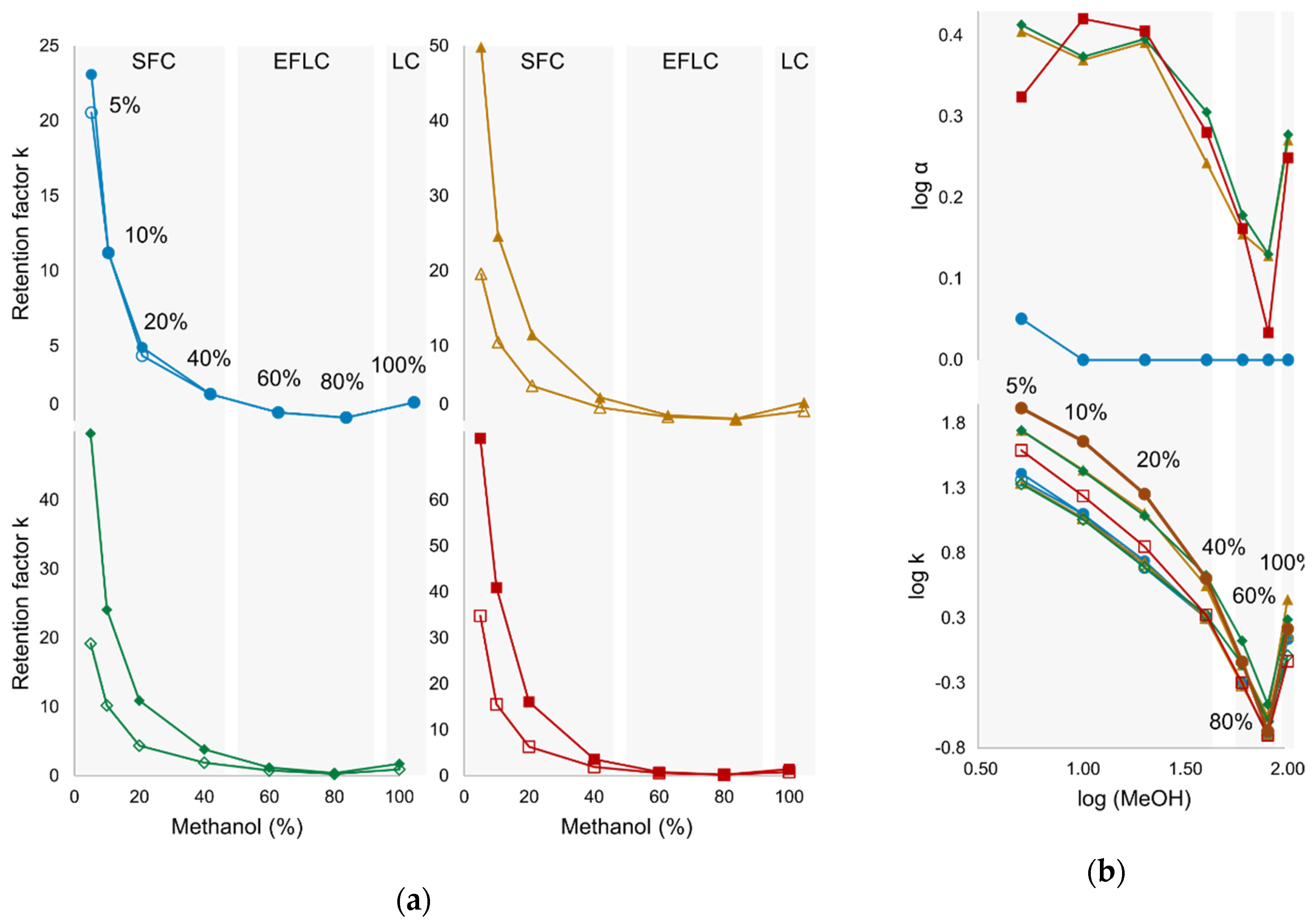

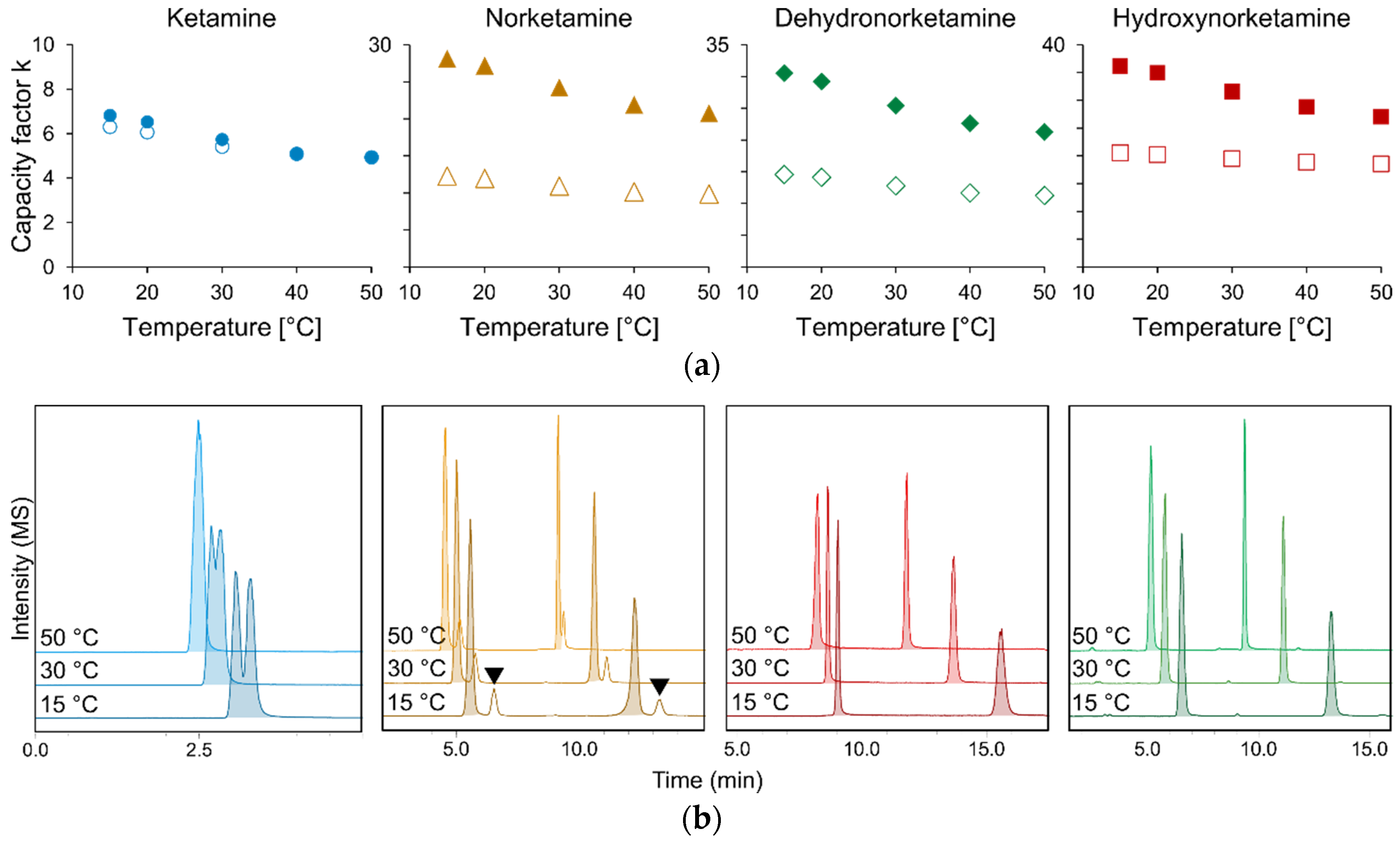
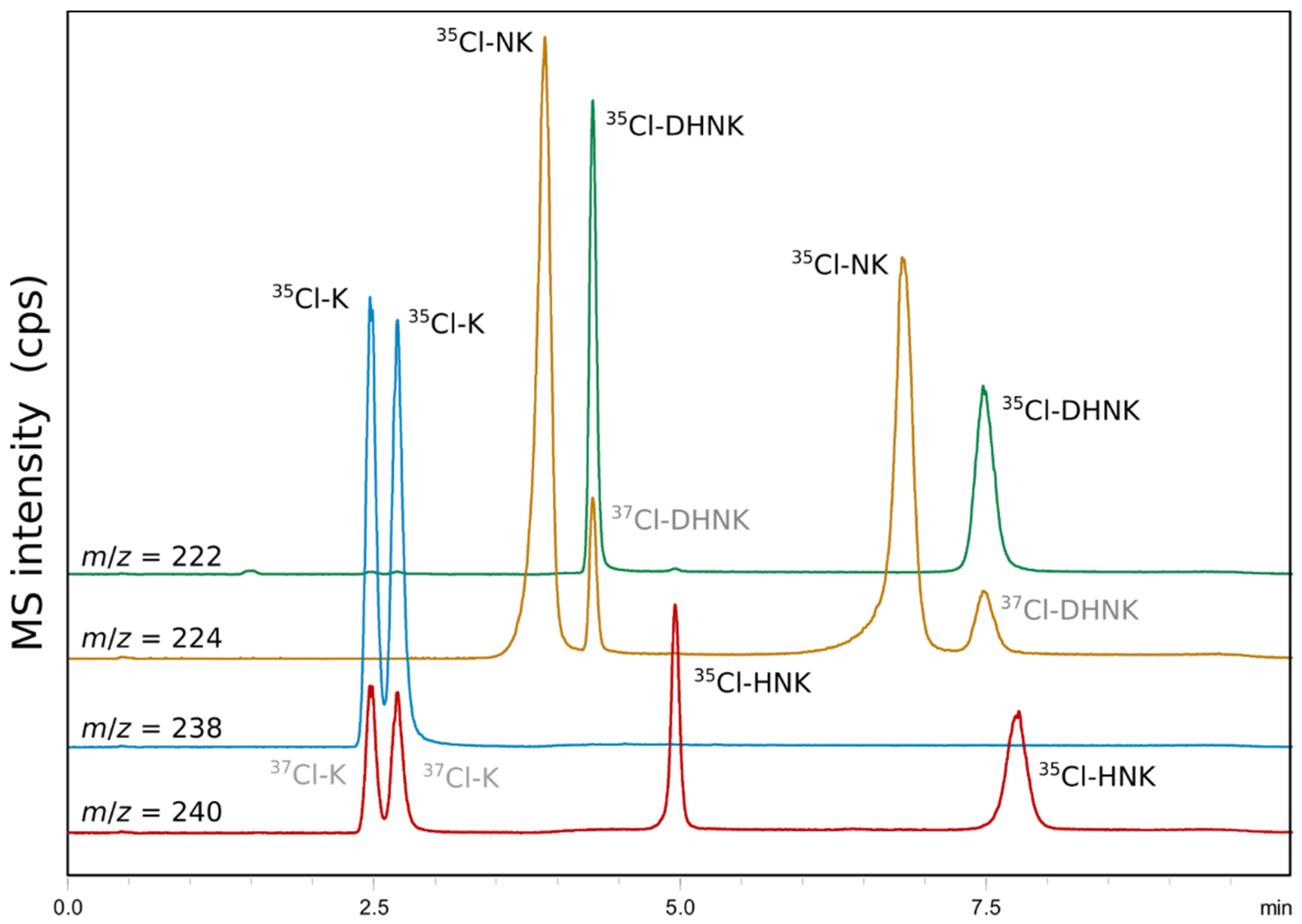


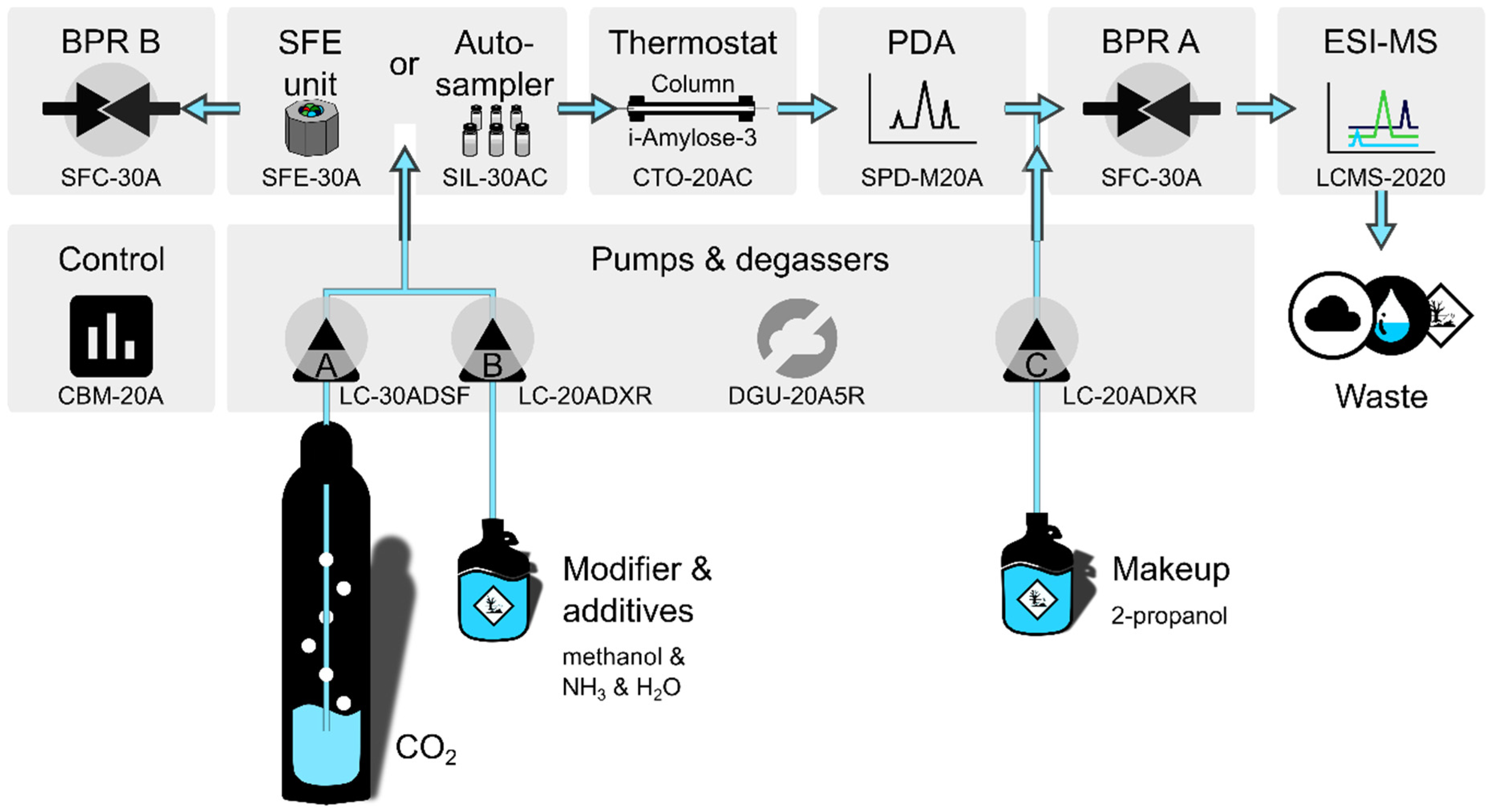
| Analyte | Amylose-2 | i-Amylose-3 | i-Cellulose-5 | ||||||
|---|---|---|---|---|---|---|---|---|---|
| |ΔΔG| (kcal/mol) | α 1 | α 2 | |ΔΔG| (kcal/mol) | α 1 | α 2 | |ΔΔG| (kcal/mol) | α 1 | α 2 | |
| K | 0.07 | 1.01 | 1.00 | 0.11 | 1.02 | 1.02 | 0.01 | 1.02 | 1.00 |
| NK | 0.25 | 1.09 | 1.08 | 0.23 | 1.23 | 1.14 | 0.10 | 1.28 | 1.04 |
| DHNK | 0.06 | 1.05 | 1.04 | 0.56 | 1.55 | 1.20 | 0.28 | 1.10 | 1.28 |
| HNK | 0.17 | 1.01 | 1.16 | 0.52 | 1.59 | 1.40 | 0.10 | 1.77 | 1.11 |
| Mode | B | FR | t0 | K | NK | DHNK | HNK | ||||||||
|---|---|---|---|---|---|---|---|---|---|---|---|---|---|---|---|
| (%) | (mL/min) | (min) | Rt 1 | k | α | Rt 1 | k | α | Rt 1 | k | α | Rt 1 | k | α | |
| SFC | 5 | 2.5 | 0.23 | 4.98 | 23.1 | 1.1 | 4.76 | 49.8 | 2.5 | 4.66 | 49.7 | 2.6 | 8.27 | 73.4 | 2.1 |
| 10 | 2.0 | 0.28 | 3.38 | 11.2 | 1.0 | 3.19 | 24.6 | 2.3 | 3.10 | 24.1 | 2.4 | 4.57 | 40.9 | 2.6 | |
| 20 | 1.5 | 0.37 | 2.10 | 4.6 | 1.0 | 2.12 | 11.5 | 2.5 | 2.01 | 10.9 | 2.5 | 2.73 | 16.1 | 2.5 | |
| 40 | 1.0 | 0.61 | 1.71 | 1.8 | 1.0 | 1.72 | 3.2 | 1.8 | 1.77 | 3.8 | 2.0 | 1.77 | 3.6 | 1.9 | |
| EFLC | 60 | 0.6 | 0.90 | 1.40 | 0.6 | 1.0 | 1.39 | 0.8 | 1.4 | 1.61 | 1.2 | 1.5 | 1.41 | 0.8 | 1.5 |
| 80 | 0.5 | 1.13 | 1.38 | 0.2 | 1.0 | 1.39 | 0.3 | 1.3 | 1.45 | 0.4 | 1.3 | 1.38 | 0.2 | 1.1 | |
| HPLC | 100 | 0.4 | 1.32 | 2.96 | 1.2 | 1.0 | 3.08 | 2.5 | 1.9 | 2.53 | 1.7 | 1.9 | 2.42 | 1.5 | 1.8 |
| Analyte | First Eluting Enantiomer | Second Eluting Enantiomer | Resolution | ||
|---|---|---|---|---|---|
| Rt ± SD (min) | RSD (%) | Rt ± SD (min) | RSD (%) | Rs | |
| K | 2.466 ± 0.028 | 1.13 | 2.680 ± 0.038 | 1.44 | 1.33 |
| NK | 3.893 ± 0.017 | 0.45 | 6.793 ± 0.072 | 1.06 | 12.40 |
| DHNK | 4.281 ± 0.022 | 0.52 | 7.425 ± 0.090 | 1.25 | 16.42 |
| HNK | 4.956 ± 0.021 | 0.43 | 7.729 ± 0.042 | 0.54 | 13.04 |
© 2019 by the authors. Licensee MDPI, Basel, Switzerland. This article is an open access article distributed under the terms and conditions of the Creative Commons Attribution (CC BY) license (http://creativecommons.org/licenses/by/4.0/).
Share and Cite
Hofstetter, R.K.; Potlitz, F.; Schulig, L.; Kim, S.; Hasan, M.; Link, A. Subcritical Fluid Chromatography at Sub-Ambient Temperatures for the Chiral Resolution of Ketamine Metabolites with Rapid-Onset Antidepressant Effects. Molecules 2019, 24, 1927. https://doi.org/10.3390/molecules24101927
Hofstetter RK, Potlitz F, Schulig L, Kim S, Hasan M, Link A. Subcritical Fluid Chromatography at Sub-Ambient Temperatures for the Chiral Resolution of Ketamine Metabolites with Rapid-Onset Antidepressant Effects. Molecules. 2019; 24(10):1927. https://doi.org/10.3390/molecules24101927
Chicago/Turabian StyleHofstetter, Robert K., Felix Potlitz, Lukas Schulig, Simon Kim, Mahmoud Hasan, and Andreas Link. 2019. "Subcritical Fluid Chromatography at Sub-Ambient Temperatures for the Chiral Resolution of Ketamine Metabolites with Rapid-Onset Antidepressant Effects" Molecules 24, no. 10: 1927. https://doi.org/10.3390/molecules24101927
APA StyleHofstetter, R. K., Potlitz, F., Schulig, L., Kim, S., Hasan, M., & Link, A. (2019). Subcritical Fluid Chromatography at Sub-Ambient Temperatures for the Chiral Resolution of Ketamine Metabolites with Rapid-Onset Antidepressant Effects. Molecules, 24(10), 1927. https://doi.org/10.3390/molecules24101927





